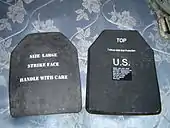Trauma plate
A trauma plate, also known as an armour plate or ballistic plate, is a protective armoured plate inserted into a carrier or bulletproof vest, that can protect by itself, or increase the protection of the vest.

It serves to defeat higher threats, and may be considered as a form of applique armour. It is usually inserted into the front and back, with side inserts also sometimes used. There are also plates for other regions, such as the shoulders,[1] lap, and throat.[2]
Dimensions and sizing
Trauma plates can be found in a variety of sizes and shapes.[3] In the industry, armour plate shapes are common referred to as a cut, in reference to how the strike face must be cut from the material. The most common are the:
- SAPI Cut, a rectangle with two sloped cuts on the top two corners, the name being derived from the SAPI armour plate. Similar is the Shooter's Cut.
- Swimmer's Cut, similar to a stretched trapezoid on top of a rectangle. Used by SEALs and other seaborne units.
- Rectangle/Square, a rectangular armoured plate with rounded off corners. Somewhat antiquated due to the
Most overt armour plates usually are sized to 10x12", 11x14", and other such dimnensions, however SAPI plates are slightly different.[4] In addition, armour plates may be curved to assist in the user's comfort and ergonomics.
Materials
Most trauma plates or pads are made of a combination of materials. The following categories denote the primary material used in different plate packages.
Ceramic
Ceramic plates or ceramic armor, typically composed of boron carbide, silicon carbide, or other similar materials, are common place in military applications. The advantages of ceramic armor is that they are not only lighter than metals, but much harder as well, which enables them to deform tungsten core penetrators, and resist ammunition at a high velocity.
Ceramic material defeats projectiles by shattering it into pieces, decreasing the penetration ability of projectile. Compared to steel or titanium, ceramic plates have inferior multi-hit resistance due to its somewhat brittle nature, although there are workarounds, as with the IM/PACT technologies demonstrated by Ceradyne, which use a stainless steel crack arrestor,[5] or the titanium arrestor of the newest GRANIT GOST 6A armoured plates fielded by Russia's Armed Forces.[6]
As such, they are vulnerable to projectiles which hit in a tight grouping, as these create a stress concentration on the plate and shatter the section of plate targeted.[7]
Metal
Most metal trauma plates are made primarily of steel or titanium, although aluminum and various alloys also exist. Steel plating, although it suffers less deformation, may suffer greater impulse generated by an impact, as the steel bends very little, and thus little energy is captured. A steel plate shatters a projectile, sending potentially dangerous fragmentation across the plane of the plate.[8] In addition, metal armour has the possibility of deflecting bullets, where they may end up in a limb, friendly personnel, bystanders, or private property. Munitions above 3100 fps have been known to penetrate commercial armour steel plates sold under NIJ Level III, most notably the 5.56 M193 round.[9] As well, the most common material, AR500 steel, or Abrasion Resistant/ Brinell Hardness 500 steel, is actually not created for armour purposes, and thus can suffer major variances in hardness According to Leeco Steel, "While often requested for ammunition target surfaces, AR500 steel plate is not certified for ballistic use".[10]
Plastic
Multi-layered sheets/plates of ultra high molecular weight polyethylene (UHMWPE) can provide an added ballistic enhancement equal to or even greater than metal plates with less weight. With these, there is the cost of less trauma reduction and the improbable but possible risk of fracture. UHMWPE can be strewn into a thread when made, and woven into a fabric that competes in strength, flexibility, and weight to modern aramid fabrics, and is now a commonly used material in vests. UHMWPE however, does have weaknesses, most notably *fix please*
Polymer
Several companies have created viscoelastic polymer compounds capable of a very high degree of energy/force dissipation as a result of shock, vibration, or g-force side loading. The material, and padding made from it, derives its superior energy adsorbing behavior from the unique physical properties of the viscoelastic compound. The bulk of the compound is composed of a high molecular weight, highly viscous, highly elastic polymer fluid. The fluid is then compounded with rheological modifiers and other fillers to control the physical and rheological properties of the finished padding compound. Zoombang is one example of a polymer compound trauma pad (ZB-7 Trauma Pad).
Nanomaterials
As a potential material for future trauma plates and anti-ballistic fabrics, carbon nanotube and nanocomposite materials offer strength to weight ratios that are potentially superior to other materials. For further information on these materials as applied to ballistics, please visit the section on ballistic vest nanomaterials in ballistics. There are plates made of nanomaterials currently available in commercial products.
Special Threats
Special threats are ratings of armour above standard ratings, such as a denotion of IV+ capability, or the ability to defeat M993 armour piercing ammunition. Such armour can range from mundane III+ plates, to exotic protections for 12.7mm projectiles.
References
- "MEHLER vario system: P1C - Amok Armour extensions". m-v-s.de. Retrieved 2020-10-06.
- "Soft Armor". AA SHIELD. Retrieved 2020-10-06.
- "Interceptor Body Armor". www.globalsecurity.org. Retrieved 2020-10-06.
- "SOCOM recalls thousands of SPEAR ballistic armor plates". Military Times. 2017-08-08. Retrieved 2020-10-06.
- http://www.washingtontimes.com, The Washington Times. "Tactical advantage: Russian military shows off impressive new gear". The Washington Times. Retrieved 2020-10-06.
- American Society of Composites (1999). American Society of Composites, Fourteenth International Conference Proceedings. CRC Press. p. 258. ISBN 1566767911.
- "The Best Steel Armor for your Bulletproof Vest". Caliber Armor. 2020-01-09. Retrieved 2020-10-06.
- "5.56 Punches Through Level III Body Armor" https://www.youtube.com/watch?v=oMYkEMhPsO8
- "AR500". www.leecosteel.com. Retrieved 2020-10-06.